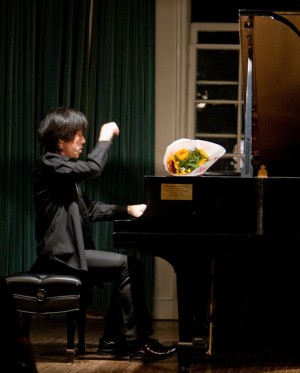Acclaim
Review
NO PUSSYFOOTING ON THE PEDALS

As the aphorism tells us it is unwise to judge a book by its cover. Yet the handsome, confident young man in the promo photos just looked too good to pass up. More than that his budding press appeared to be fully cognizant of a star in the making. To say we were not disappointed by this recital would be an understatement. Taka Kigawa is a pianist of already remarkable stature and he is but in his thirties.
We have repeated ourselves all too often regarding our shunning a concert with but one modern piece on it. But we firmly believe that you cannot understand contemporary music without looking to the past and that Ursula Oppens proved that beyond a reasonable doubt in her “Beethoven and the Moderns” series. Mr. Kigawa ended his recital with one of the most talked about works of the serial music school, Boulez's Second Sonata. If Paul Griffiths was right when he characterized Mr. Kigawa's playing as “poetry, intense, and spontaneous” (specific work or set of works unclear), then perhaps it would be fair to call his playing of the Boulez the making of poetry out of a maze of seemingly disconnected passageways. To say the least, Boulez is not the no-holds-barred favorite among today's critics. But one is convinced that Taka Kigawa knows exactly what this piece is about – he has recorded all three of Boulez's piano sonatas—and he wastes no time in demonstrating that by dispensing with the score and getting right into it.
One unfamiliar with the score will see immediately that many more auditions will be required before getting a listening handle on it. But it serves no purpose to argue that Boulez is “emotionless junk;” and we recommend to those observers that they listen to Kigawa play it, again and again. Maybe by the time he reaches the final reference to the B-A-C-H motive, they will see that Boulez has brought the inspiration of the past to the analysis of the present.
That inspiration appears in the very high baroque accomplishment of Bach in his Chromatic Fantasy and Fugue. The very idea of working out a major composition based largely on the chromatic scale, was an achievement which Bach repeated several times. One of the greatest tributes of subsequent composers was the use of the B-A-C-H motif, suggesting a chromatic phrase, B-flat, A, C, B in our current system. For example, it opened Vaughan Williams' Fourth Symphony of 1935, his most brazen and unsettling orchestral work shrewdly forecasting the difficult period the Brits would endure in a few years hence. No, Bach was not thinking about a world war, just the sonic possibilities available to him at a time when structure dominated, whether in music or church architecture. Mr. Kigawa did not approach the piece the way a Glenn Gould might have, but rather as a well formulated work of art, with all of the lovely ornamentation fully in place.
Nor did he approach the Beethoven in the same way, say, Carine Guttlerner did in her Weill Recital program (see last issue). The first movement, with its strong three-note motto, subsequently borrowed by the likes of Schubert and Mahler, sounded here like a pronouncement of great import which leads to an emotionally heated discussion finally resolved in sensibility and reason. And Kigawa took the second movement (actually several movements in one) crisply and saw it as far, far removed from the first. The dancing phrases were there and even that delightfully syncopated passage which seems to foretell the age of jazz.
No question about it. Taka Kigawa is a pianist to watch. We should be thankful that he has come to make a career in New York and, not only perform for us, but give of his great talents to young students at the GHMS.